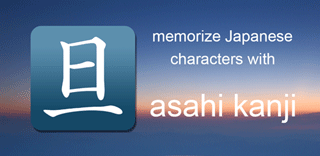

Asahi Kanji (English) application for Android
and Asahi JLPT-N5
Japanese Kanji Radicals (bushu 部首) and elements
For a presentation of the whole application please see:
https://www.japanese-kanji.com/android/english/asahikanji-en-android.htm
![]() Radicals and elements,
Radicals and elements,
the building blocks of kanji
While some kanji are very simple like 一 meaning “one”, most are comprised of multiple elements or components.
Recognizing these basic elements helps you memorize complex kanji and distinguish visually similar characters using helpful mnemonic cues.
How can you memorize a complex 18 stroke kanji like this one 繭 ?
Let’s break it down: 繭 is made of the radicals for “grass,” “enclosure,” “thread,” and “insect”, a combination that evokes the meaning “(silk) cocoon.”
When you recognize these components, you might even be able to infer the meaning of unfamiliar kanji.
Unfortunately kanji have evolved over time and for most of them there is no obvious relation between these building blocks and their meaning.
Sometimes only one element carries the meaning, another is a pronunciation clue and a third has been added for some obscure reason.
Still, using these elements as mnemonics can be invaluable, especially when distinguishing characters that look similar, such as:
牲, 性, and 姓
All three contain 生 on the right, indicating the on-yomi (Chinese reading) “sei” or “shō.”
To tell them apart, pay close attention to the left-side components.
- The first kanji 牲 is a combination of a variant of 牛,牜 (cow) + 生 (life) , meaning animal sacrifice, offering;
- the second one 性 is made up of a variant of 心,忄(heart) + life, meaning gender, sex, nature;
- the third one 姓 is made up of 女 (woman) + life, meaning surname.
![]() What is the difference between « radicals » and « elements »?
What is the difference between « radicals » and « elements »?
‘Radicals’ is usually used as a translation for (部首), the set of 214 components traditionally used to classify kanji in both Japanese and Chinese dictionaries.
Most dictionaries allow you to look up a kanji by its radical and the number of additional strokes.
In the Asahi Kanji app, ‘elements’ refers to other basic or primitive components not used as radicals.
Because they appear frequently, it is useful to learn them as well.
Examples include: マ, ユ, 乃, 及, 九, 久, 也, 亡, 五, 井, 元, 品.
Some radicals also have variants, sometimes resembling a ‘compressed’ form (金 → 釒), and other times appearing quite different (刀 → 刂).
The list titled ‘Radicals and Elements’ contains 259 items: all 214 bushu (radicals), 22 variants, and 23 extra elements.
Both the variants and extra elements are included in the drills.
Twelve complex bushu that never occur in the jōyō kanji have been placed at the end of the list and excluded from the drills.
![]() About "Japanese names" and "meanings"
About "Japanese names" and "meanings"
Please don’t take these terms too literally.
- When a radical can exist on its own as a kanji, its Japanese name usually reflects its meaning. For example, 一 is called いち (“one”), and 人 is called ひと (“person, human”).
-
When a radical never appears alone in Japanese (though it might in Chinese), its name is often mnemonic. For instance, 广 is called まだれ (madare).
麻垂れ (madare) means “the radical enclosing the top-left corner (dare) of the kanji 麻 (ma).
This works for native speakers, but it is not very helpful for foreign learners who may not know the kanji 麻 (ma) yet.
For this reason, radicals are often given more explicit mnemonics. 广, for example, is usually described as “dotted cliff” in English and "maison sur une falaise" (house on a cliff) in French. - Elements that are not bushu are either kana or kanji, and are often named after their most common reading. For example, 九 is read as キュウ (“nine”).
![]() Features
Features
- A scrolling list of 259 radicals, variants and elements.
A tap on an item opens the corresponding flashcard.
This list is used for navigation through the stack of cards. - A typical stack of flashcards .
- Display can be toggled on and off for all panels (radical, variants if any, meaning, Japanese name, English name or mnemonics and sample kanji.
- Four multiple choice drills radicals >> elements and elements >> radicals.
- Possibility to mark known radicals in order to exclude them from the tests.
- Repeat (a stack of cards populated with the wrong answers from the tests)
- Report displaying your score for each drill.
![]() The Radicals Flashcards / Review mode
The Radicals Flashcards / Review mode
Suggestions for using the flashcards:
Browse the stack using the scrolling list.
In the Flashcards panel hide the meanings and names and flip through the cards.” → “In the Flashcards panel, hide the meanings and names, then flip through the cards.
If you recognize the radical shown, tap the ± (+/- )icon to mark it as known. (Tap again to toggle.)
Radicals marked as "known" will be excluded from the drills, until you reset them to the "unknown" state, either individually or in bulk in the Settings panel.
Your choices will be saved in the database and you can safely leave the app or turn off your device at any time.
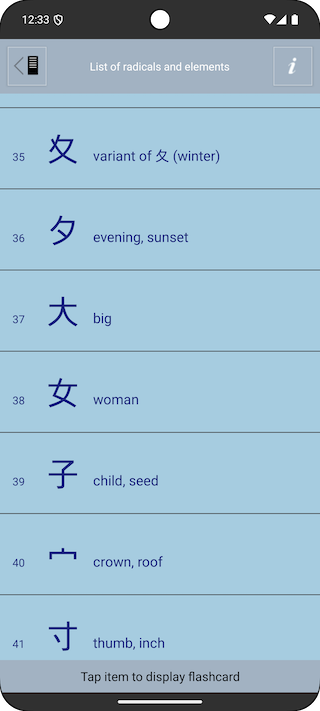
There are 259 cards in the database but some complex bushu which never appear in Jōyō kanji are not included in the tests.
Each card displays a radical, its variant(s) if any, its meaning or mnemonics, its Japanese name and Jōyō kanji examples.
You can toggle the visibility of items on the cards with a touch on the various panels.
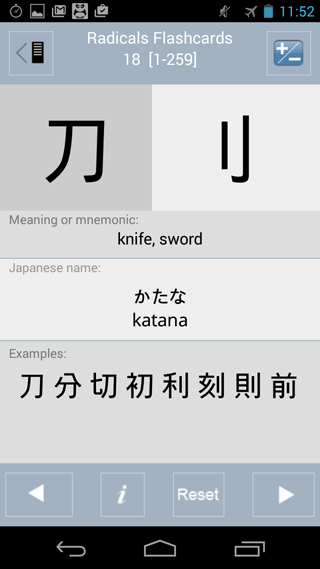
![]() The drills or practice tests
The drills or practice tests
There are two types of multiple choice questions or tests (MCQ).
2) The Radical >> Meaning MQC displays 1 radical and 4 sets of meanings from which to choose from.
3) The Meaning >> Radical MQC displays 1 meaning and ask you to choose the corresponding radical.
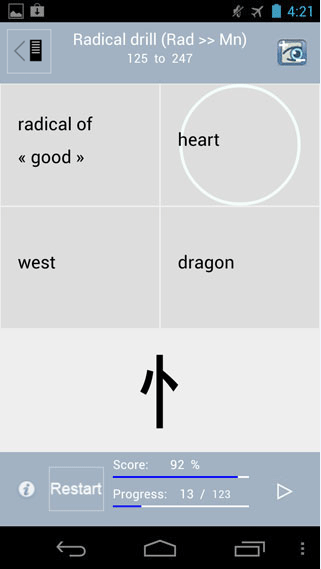
Whenever you make a mistake, you can have a look at the corresponding card with a touch on the eye icon.
You can do the same with the correct answer, display the corresponding card and mark the kanji as known if you wish to exclude it from future exercises.
You will be able to resume any interrupted exercise where you left it, even if it is killed by the system when it needs more memory.
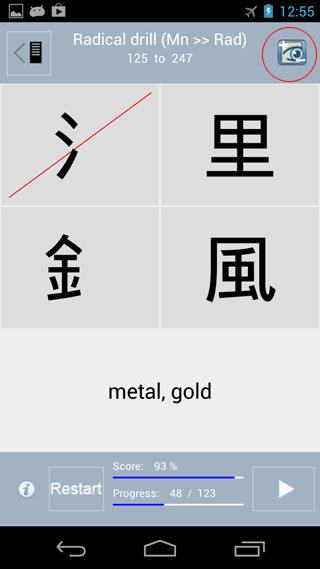
![]() Repeat
Repeat
In the "Repeat" stack, you will find
radicals and elements you should concentrate on.
As you go through the drills, the program memorizes the wrong choices you made,
together with the radicals you should have chosen.
The behavior of the cards is the same as in the Flashcards / Review stack : you will be
able to hide or display the meanings and examples with a touch on the panels (toggle).
You can also mark radicals as "known" in order to exclude them from future drills, until you reset them to the "unknown" state.
The cards in the Repeat stack are displayed in an endless loop, whether you use the Next or Previous buttons.
Their order is randomized each time you open this activity.
The Reset button enables you to empty the Repeat stack of cards.
![]() Report
Report
The Report screen is common to the kanji and radical drills. It is accessible from the top menu.
The Report screen displays the results of completed drills only.
In this version your scores are not saved automatically. If the application is killed by the system when it needs more memory for another task,
the displayed data will be erased.
Therefore, if you wish to keep track of your progress, you must save your scores
as an email message. Asahi Kanji will launch your default mail program and populate a message with your results.
You can save this message as a draft on your device or send it to yourself.
This application has no access to your address book and you will have to fill in the mailing address yourself.
![]() Settings
Settings
In the Radicals Flashcards and Repeat drills you can mark or unmark cards as "known" with a tap on the +/- icon.
Cards marked as known are then excluded from future drills.
In this version "settings" are limited to resetting "known" radicals to the "unknown" state and emptying the Repeat stack of cards.
After you reset the whole stack of cards to the "unknown" state, all radicals will again be included in the drills.
![]() Memory management
Memory management
You can leave an uncompleted drill and switch to another application. When you reopen Asahi Kanji you will be able to resume any unfinished drill where you have left it.
When a drill is completed it is automatically reinitialized when you return to the Top menu.
Please note that when cards are marked or unmarked as "known", unfinished drills are automatically reset, since the number of cards affects the scores and progress.
For a presentation of the whole application please see:
https://www.japanese-kanji.com/android/english/asahikanji-en-android.htm